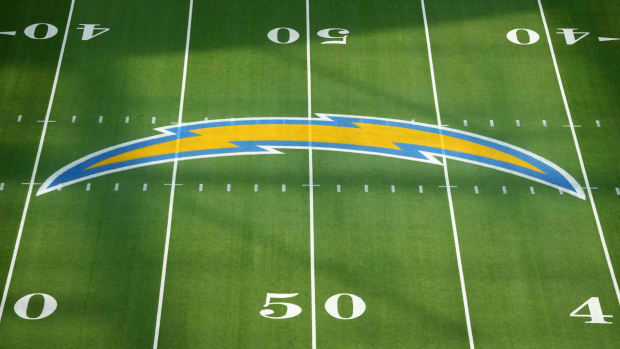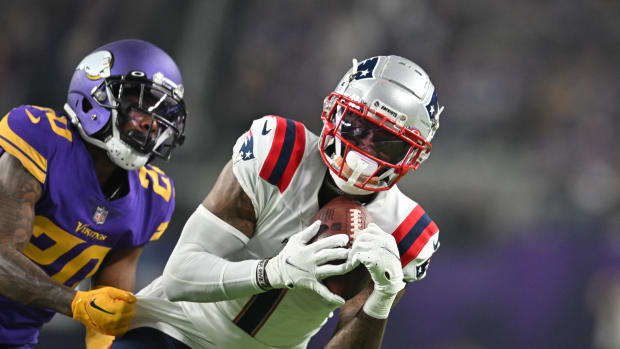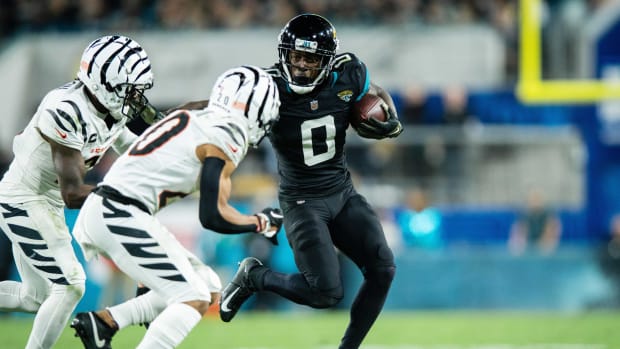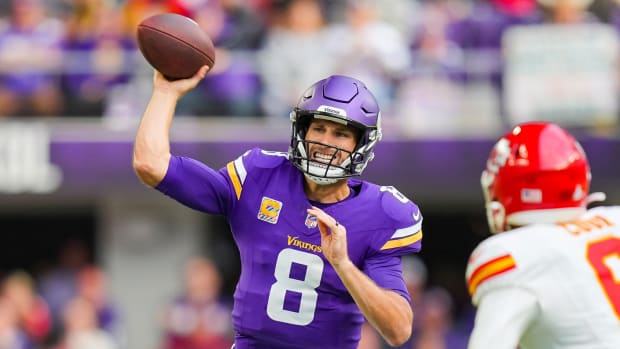Titans Preview: Can Defensive Creativity Carry Them?
Jurrell Casey (right) and Bernard Pollard will lead Ray Horton's aggressive scheme. (Vincent Pugliese/Getty Images)
Defense
Another summer, another major adjustment the Titans’ defensive personnel has to make. Last season they transitioned from the vanilla, zone-based scheme of defensive coordinator Jerry Gray to the more diverse, complex system of Gray’s top lieutenant, Gregg Williams. This year, they’re transitioning into a voluminous, highly creative, attack-oriented scheme under new head coach Ken Whisenhunt and, more specifically, hand-picked defensive coordinator Ray Horton.
Whisenhunt is installing his own offensive system as well, but Tennessee’s playoff hopes reside on defense. While the offense hopes to break even, Horton’s new group can be dynamic and big-play oriented.
Horton is one of the few defensive coaches who still runs a traditional 3-4. He only does so on base downs, of course. In third-down passing situations, his scheme transforms into any number of things. He has a smorgasbord of pressure packages, many involving six-man blitzes or elongated zone exchange concepts. A lot of it comes from amorphous pre-snap looks. When it clicks, it’s one of the best—if not the best—defensive schemes in football. Horton’s daringness and sense for when to call certain blitzes is terrific.
But what kind of growing pains will Tennessee go through in 2014?
When he debuted as Arizona’s defensive coordinator three years ago, Horton told co-workers that he was going to throw the whole gauntlet at his men right away, and that there might be some difficult learning curves early on. But down the stretch, if would pay off.
That’s exactly what happened. Working against Horton that year was the NFL lockout, which prevented him from installing his scheme before August. (Time isn’t a big issue this year.) Working for Horton was that he had a certifiable top-tier man-to-man corner in Patrick Peterson.
With Alterraun Verner’s departure in free agency, Horton’s unit does not have any great man coverage corners. Jason McCourty has blossomed nicely, but the sixth-year pro is more of an off-coverage defender, not a gritty bump-and-run artist.
Horton, here instructing slot corner Coty Sensabaugh, worked with Ken Whisenhunt in Arizona. (Mark Humphrey/AP)
McCourty is better suited to be part of a system rather than the fulcrum. But the Titans may not have a choice. The No. 2 corner is expected to be Blidi Wreh-Wilson, a 2013 third-round pick who played just 93 defensive snaps over 13 games last year. The fact that Wreh-Wilson is starting highlights a lack of depth at corner, though encouragingly, the Titans do have a stellar young nickel slot in Coty Sensabaugh.
At safety, Michael Griffin is a good, though up-and-down coverage guy. And they have a bona fide nose-breaker in Bernard Pollard, who often plays like a fifth linebacker. Pollard will be a critical component of Horton’s blitz packages.
The beauty of those blitz packages is that they minimize the necessity of a first-class edge-rusher, something Horton could make great use of but is not dependent on. He doesn’t have one here anyway. Kamerion Wimbley, who has toggled between outside backer and 4-3 defensive end throughout his career, will get a blocker’s attention but rarely burn him on his first step. Derrick Morgan seems on track to be Wimbley 2.0. A defensive end throughout his five-year career, Morgan must learn to play from a standup position. The former first-round pick does not have sterling initial quickness, though he is a very fine five-tool athlete who can generate pressure through his second effort and well-honed technique. Offenses aren’t sliding protections to Morgan’s side, though.
Last year, Morgan saw some of his snaps go to fifth-round rookie Lavar Edwards. This year, he’ll rotate with Akeem Ayers, who played a host of different roles in the previous scheme and will be an athletic chess piece in Horton’s. Ayers is not Tennessee’s most cultivated pass rusher, but he’s the most explosive.
The options at outside linebacker seem scant compared to those inside. Free agent pickup Wesley Woodyard is assured one starting job, and his fluidity in coverage will keep him on the field in nickel. But who joins him? In the base 3-4, Colin McCarthy is the best run defender, though injuries and inconsistency (possibly related) have been a concern over his three-year career. Last year Moise Fokou took most of the reps, but he’s not as athletic as Zach Brown, who isn’t as heady as any of the players above. And then there’s Zaviar Gooden, who struggled mightily with keys and diagnostics as a rookie last season but has third-round physical tools. With inside linebackers critical to everything Horton does (he loves to use them on zone blitzes and pre-snap disguise), the job will likely go to whichever young player exhibits the highest football IQ.
The collateral damage of a scheme change is that good players sometimes get recast in ill-fitting positions. Hopefully that won’t prove to be with Jurrell Casey. The fourth-year pro shed 15 pounds from his rotund frame this offseason in hopes of improving his quickness and agility as he moves from three-technique to hybrid five-technique (the same role that Cardinals star Darnell Dockett filled under Horton). Casey, with his high motor and sense for disengaging blocks, should thrive. But he was more than thriving in his old role. Aside from maybe Tampa Bay’s Gerald McCoy, Casey was the best three-technique in the NFL last season.
Casey’s backups Karl Klug and Mike Martin have both seen significant snaps at various times in their young careers, though they too might have trouble being cast in the new scheme. At least Ropati Pitoitua won’t. The seventh-year veteran played 3-4 defensive end for the Jets and Chiefs prior to coming to Nashville. Despite being a stretched 6-8 and 315 pounds, Pitoitua plays with a great center of gravity that accentuates his natural power. He’ll start ahead of ex-Steelers backup Al Woods and fourth-round rookie DaQuan Jones, a 320-pounder from Penn State. Inside, Sammie Hill and Antonio Johnson will share duties. Neither is quite a true nose tackle, though both played fine as nose shades in 2013, aligning over, but not quite head-up on, the center.
Three years after being drafted eighth overall, Jake Locker is still trying to prove he can play in the pocket. (Patrick Murphy-Racey for Sports Illustrated)
OFFENSE
Whisenhunt’s two best years directing offenses were, arguably, 2008 in Arizona and last season in San Diego. In both cases, he had a quarterback who was willing to make tough throws with defenders in his face and able to diagnose the defense before the snap.
Jake Locker fulfills the former stipulation; his grit and courage are unquestionable. As for the latter, he doesn’t come close. His awareness before the snap is, like his awareness after it, limited. Locker’s entering his fourth season, but injuries have kept him to only 23 games (18 starts). That’s the consequence of having great toughness but limited field awareness, and it’s one of the reasons Tennessee did not pick up Locker’s fifth-year option.
To Locker’s credit, he improved his mechanics and accuracy last season, getting his completion percentage over 60% for the first time. It helped that his decision-making was tightly managed by simplified play designs. There were very few vertical concepts in Tennessee’s passing game, and Locker was often able to throw to his first read. He was uncomfortable going any deeper in the progressions, though.
One Errant Throw: The MMQB RV Tour stopped in at Titans camp
The current Titans regime does not have as much stake in Locker’s success. It’s an all-new coaching staff, and while GM Ruston Webster was with the franchise when Locker was drafted eighth overall in 2011, he wasn’t the final decision-maker. Zach Mettenberger, on the other hand, was brought in by this regime. Obviously they’re not head over heels for the ex-LSU Tiger; if they were, they would have selected him earlier than the sixth. But they might find that Mettenberger, a big, traditional pocket passer, is actually the best fit for Whisenhunt’s system.
Whoever is under center, Whisenhunt will have to manufacture a passing attack that has defined reads. Last season the Titans did a lot with crossing patterns, which you can expect again, as that capitalizes on wideout Nate Washington’s proficiency on the move and Kendall Wright’s excellent short area quickness and body control.
The play of big, athletic wideout Justin Hunter (yes, he held onto this Jake Locker TD pass last September) will go a long way towards determining how explosive this offense is. (Mark Zaleski/AP)
How dynamic Tennessee’s receiving corps is will depend on Dexter McCluster and Justin Hunter. McCluster is the multifaceted weapon underneath (though, frankly, not a great one); Hunter, with his strong hands, long-striding speed and ability to high-point the ball, is the lone deep threat. Tight end Delanie Walker also factors in here. He was an extremely diverse piece in San Francisco’s offense two years ago and, after a quiet debut here last season, figures to be critical in Whisenhunt’s system.
Walker can bring an invaluable dimension to run-blocking designs, which is where Tennessee’s ground game will find its potency. Shonn Greene is an average downhill back who, after offseason knee problems, might not even be reliable for 16 games. Second-round rookie Bishop Sankey could wind up the feature horse, effectively replacing the declining and departed Chris Johnson.
Tasked with making these ballcarriers look good is a front five that could feature two first-round picks on the right side: guard Chance Warmack (drafted 10th overall last year) and tackle Taylor Lewan (taken 11th this year). Warmack has the physical tools to dominate, but he was very uneven in his mechanics and balance last season, especially on zone plays. At this point, he’s a much better man-blocker. Lewan doesn’t figure to work on the right side for long; Michael Roos, one of the league’s steadiest left tackles over the years, is in decline and has an expiring contract. Lewan was unofficially drafted to replace him.
Michael Oher probably never imagined he’d be coming off the bench when he signed a four-year, $20 million contract with the Titans in free agency, but that will be the case if Lewan starts as a rookie. Typically one of the two would play guard, but that’s not an option with Warmack on the right and expensive Pro Bowl caliber veteran Andy Levitre on the left. At center, second-year pro Brian Schwenke must show better athletic command. Otherwise, this potentially imposing front five will be weak in the middle.
SPECIAL TEAMS
Instead of paying Rob Bironas around $3 million, the Titans will try their luck with either Maikon Bonani or Travis Coons, whichever undrafted youngster wins the kicking competition. Punter Brett Kern can also dabble in field goals. In the return game, veteran speedster Leon Washington or injury-riddled Pro Bowler Marc Mariani will get the nod.









































